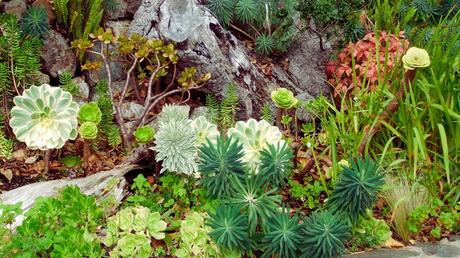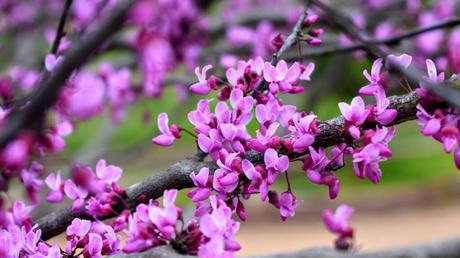
Last Updated on July 18, 2023 by Kravelv
In today's world, water is a precious resource, and conserving it has become a top priority for many homeowners. That's where xeriscaping comes in. Xeriscaping is a landscaping method that utilizes drought-tolerant plants to create an aesthetically pleasing and water-smart landscape. In this article, we will introduce you to 30 of the best drought-tolerant plants for xeriscaping that will help you create a beautiful and sustainable garden.
Drought-Tolerant Plants for Xeriscaping
Agave Americana - Agave Americana is a beautiful succulent that stands out due to its enormous, blue-green leaves that are arranged in a rosette pattern. This makes it an ideal focal point for any garden.
Blackfoot Daisy - Blackfoot Daisy is a low-growing perennial that is compact and produces delicate blooms that resemble daisies and have yellow centers and white petals. These flowers bloom continuously throughout the summer.
Cape Honeysuckle - Hummingbirds and honeybees will be drawn to your garden by the vibrant orange-red blossoms of the cape honeysuckle, a woody climbing vine that blooms during the summer months.
California Fuchsia - The California Fuchsia is a hardy perennial that is known for its beautiful orange-red blooms that are known to attract hummingbirds and butterflies. As a result, this plant is a well-liked option for xeriscaping.
Blue Sage - Blue Sage is a fragrant perennial herb that, throughout the summer months, produces gorgeous blooms that are a mixture of blue and purple, which bring pollinators like bees and butterflies to your garden.
Chaste Tree - The Chaste Tree is a type of tiny deciduous tree that is known for its pleasantly scented, lavender-blue blooms that bloom throughout the summer months and bring butterflies and bees to your yard.
Desert Marigold - Desert Marigold is an excellent option for xeriscaping since it is a low-growing perennial that is resistant to dryness and provides bright yellow blooms that bloom continuously throughout the year.
Dwarf Pomegranate - The Dwarf Pomegranate is a deciduous shrub that bears lovely and brilliant red-orange flowers in the summertime, which are followed by fruit that is both tiny and tasty.
Hens and Chicks - A succulent that is low-growing and develops rosettes of fleshy leaves in a range of hues, Hens and Chicks is a popular option for xeriscaping because of its versatility in terms of color.
Golden Barrel Cactus - The Golden Barrel Cactus is a one-of-a-kind species of cactus that is characterized by its circular, barrel-like form. During the summer months, this cactus blooms with lovely golden flowers, making it an excellent addition to any xeriscape garden.
Indian Hawthorn - The Indian Hawthorn is a tiny evergreen shrub that can have pink or white blooms throughout the spring months. These flowers are followed by dark blue berries once they have bloomed.
Lavender - Lavender is a fragrant perennial plant that has gorgeous purple blooms that bloom throughout the summer months. Bees and butterflies will be drawn to your garden because of the presence of lavender.
Mexican Feather Grass - The Mexican Feather Grass has a delicate appearance and produces elegant, golden-yellow plumes that move gracefully in the breeze. Because of these characteristics, it is an excellent option for xeriscaping.
Ocotillo - Hummingbirds will be drawn to your yard by the presence of ocotillos, which are big, prickly shrubs with long, reddish-orange blooms that bloom in the spring.
Prickly Pear Cactus - This well-known species of cactus blooms with vibrant yellow or red flowers throughout the summer months, which are followed by edible fruit that is utilized in a wide variety of culinary preparations.
Purple Coneflower - Purple Coneflower is a well-liked perennial that, when it blooms, creates stunning flowers that resemble daisies and have purple petals and brown centers. These flowers will bring butterflies and bees to your garden.
Red Yucca - The Red Yucca is a gorgeous succulent that blooms with towering spikes of pink or red flowers during the summer months. Its leaves are long and thin, and the plant itself is rather tall.
Rosemary - Rosemary is a perennial herb with a strong aroma with blossoms that can be blue or purple. It blooms throughout the summer months and brings pollinators like bees and butterflies to your garden.
Russian Sage - A fragrant perennial plant, Russian Sage is distinguished by its silvery-gray leaves and erect spikes of lavender-blue flowers that bloom throughout the warmer months of the year.
Saguaro Cactus - This towering cactus is the quintessential representation of the American Southwest. It may reach a height of up to 40 feet and, during the summer months, it bears white blooms that are pollinated by bees and birds.
Santa Barbara Daisy - The Santa Barbara Daisy is a low-growing perennial plant that is evergreen and produces blooms that resemble daisies and have white petals and yellow centers. These flowers bloom continuously throughout the year.
Sedum - A sedum is a low-growing succulent plant that has fleshy leaves and clusters of tiny, star-shaped blooms in various hues of pink, red, and white. Sedums may be identified by their appearance.
Spanish Lavender - Spanish Lavender is a fragrant perennial plant that grows silver-green leaves and tall spikes of deep purple flowers throughout the warm months of the year. It gets its name from the Spanish word for silver.
Stonecrop - Stonecrop is a kind of succulent that grows very slowly and has spongy leaves and clusters of little blooms that resemble stars and come in pink, red, and white colors.
Texas Redbud - Bees and butterflies will be drawn to your landscape by the Texas Redbud, a little tree that is deciduous and can be either pink or purple in appearance. These magnificent blossoms bloom in the springtime.

Thyme - Thyme is a perennial herb that is pungent and has little flowers that can be pink or purple. It blooms throughout the summer months and brings pollinators like bees and butterflies to your garden.
Verbena - A low-growing perennial known as verbena, attracts butterflies and bees to your garden by producing clusters of tiny, vivid blooms in various shades of pink, red, and purple as well as other colors.
Woolly Butterfly Bush - The Woolly Butterfly Bush is a shrub that can withstand dry conditions well. It has silvery-green leaves and spikes of tiny, lavender-pink flowers that bloom continuously throughout the summer months. Hummingbirds and butterflies will be drawn to your garden because of these beautiful blossoms.
Yarrow - Yarrow is a type of perennial plant that has delicate leaves that resemble ferns and clusters of tiny flowers that come in a variety of vivid colors including pink, red, and yellow.
Yellow Bells - Hummingbirds will be drawn to your yard by the Yellow Bells, a little drought-resistant tree with vivid yellow blooms in the shape of trumpets that bloom continuously throughout the summer months.
Xeriscaping is not only an efficient method of gardening in terms of water use, but it also provides homeowners with an alternative that is easy to maintain and kind to the environment. You can build a beautiful and sustainable garden that flourishes even in the worst conditions by including drought-tolerant plants in your landscape design. This will allow you to make the most of your outdoor space.
Xeriscaping Plants FAQs
What are drought-tolerant plants?
Plants that can withstand periods of drought are a subset of plant species that have evolved to thrive in arid conditions. They can flourish even in the worst conditions and use far less water than the standard plants used in landscaping.
What are the benefits of using drought-tolerant plants in landscaping?
It is possible to minimize the amount of water used in landscaping, cut down on the amount of upkeep required, and create a more environmentally responsible choice by using plants that can survive in dry conditions. Additionally, it might help you save money on your monthly water costs and increase the value of your house.
Also read: Xeriscaping Benefits
How do I choose the right drought-tolerant plants for my garden?
It is essential to take into account aspects such as your climate, soil type, and the amount of light exposure when selecting plants that can withstand drought. Conduct research to choose plants that will thrive in the growing conditions you provide and that will also enhance the appearance of your current landscape design.
Can drought-tolerant plants still be beautiful?
Absolutely! Flowering perennials, ornamental grasses, and shrubs, as well as other types of drought-resistant plants, may all be used in a landscape design to create a visually appealing and vibrant outdoor space. You may cultivate a garden that is both beautiful and self-sufficient if you choose the correct kinds of plants and give careful consideration to the layout of the space.
How do I care for drought-tolerant plants?
Even though drought-resistant plants have a lower water requirement than other types of plants used in landscaping, they still need the same level of care and attention in order to grow. This involves providing them with consistent irrigation over their first few growing seasons in order to assist them in the establishment of extensive root systems, as well as providing them with occasional fertilizer and trimming as required.
In addition to this, it is essential to keep a close eye out for any illnesses or pests that may be affecting your plants and to take appropriate action as soon as you become aware of any problems.
Final words
In conclusion, xeriscaping is an intelligent and sustainable method that can be used to produce a beautiful landscape that requires little upkeep and helps to preserve water and protect the environment. You will be able to cultivate a flourishing and environmentally-friendly garden that enhances the aesthetic appeal of your property and increases its worth if you include these thirty xeriscaping plants in your landscaping design.
